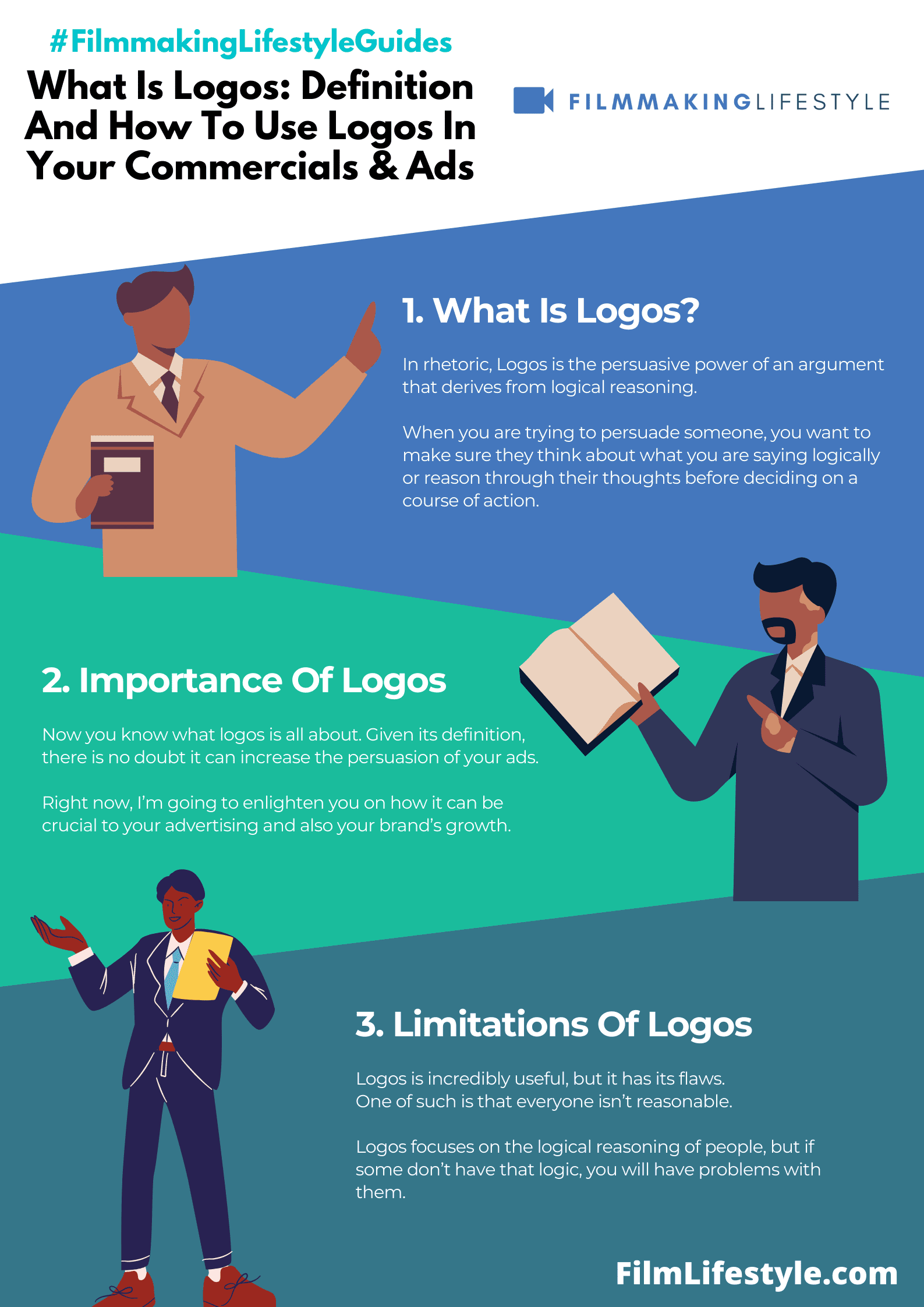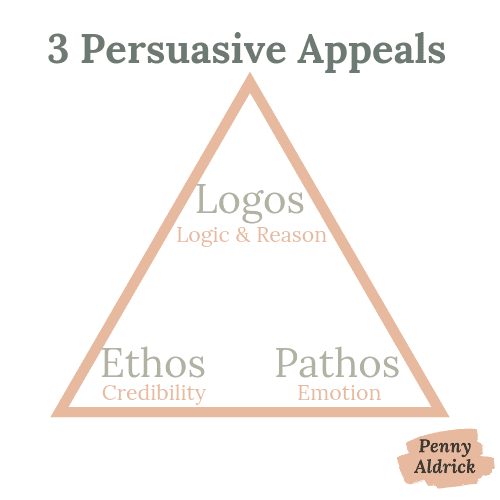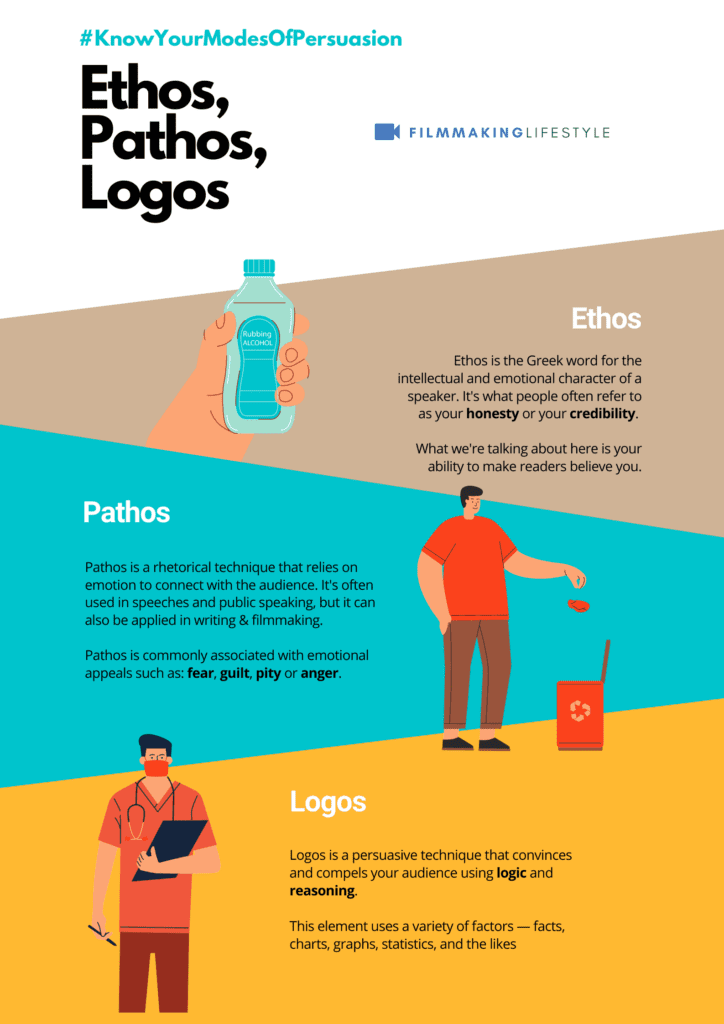Want to make your statements stick in your audience’s minds and also prompt them to act on the spot?
Let’s start with a real-life example and data to enlighten the question further.
Have you ever said something to someone and that person doesn’t believe what you say?
Or maybe someone asked you where you got your opinion from or how it was formed
And if you didn’t give them a worthy answer, they most likely brushed your viewpoint off, claiming it was worthless.
Sound familiar?
If so, then you may have presented your opinions and ideas without the essence of reasoning and rhetoric.
That’s how it is — people trust information that comes from authentic sources or data that comes from proven studies and research.
LOGOS DEFINITION
What Is Logos?
In rhetoric, Logos is the persuasive power of an argument that derives from logical reasoning.
When you are trying to persuade someone, you want to make sure they think about what you are saying logically or reason through their thoughts before deciding on a course of action.
Logos is persuasive because it appeals to the intellect, rationality, and reason. A good argument contains logos by using facts or data to support the idea without attacking the opponent’s position.
The three main types of rhetoric are Logos (logic), Ethos (character), and Pathos (emotion).
Logos is the art of persuasion through logical reasoning, a cornerstone of effective communication.
It’s about constructing arguments that resonate with clarity and rationality.
We’ll jump into the essence of logos and reveal how you can harness its power to craft compelling messages.
Whether you’re delivering a presentation or writing an article, understanding logos is key to influencing your audience.
Stay tuned as we unpack the strategies to make logos work for you.
What Is Logos?
Logos is at the heart of our storytelling and persuasive communication in filmmaking.
It’s the cornerstone of crafting a narrative that resonates with logic and reason.
In the realm of argumentation, logos refers to an appeal to logic.
We use facts, statistics, and logical arguments to convince our audience of our point of view.
The strength of logos lies in its ability to present clear, logical reasons why a particular conclusion or idea should be accepted.
When we craft our films, we rely on logos to support the narrative structure and make the story compelling.
Harnessing logos effectively means presenting information in a coherent and reasoned manner.
It requires us to ensure that our storytelling is not only engaging but also intellectually sound.
Effective use of logos involves:
- Establishing a clear connection between the story and the evidence presented,
- Utilizing credible sources to back up claims,
- Presenting arguments in a methodical and organized way.
Logos is not just about the dry presentation of facts.
It’s about weaving those facts into a narrative that’s persuasive and emotionally engaging.
For us filmmakers, logos is the invisible thread that holds the story together.
Without it, our films could lack the substance needed to truly impact our audience and leave a lasting impression.
By mastering logos, we ensure our films have a solid foundation built on logical persuasion.
It empowers our storytelling, reinforcing the emotional connection with our audience through rational appeal.
The Power Of Logos In Persuasion
The art of persuasion in filmmaking hinges significantly on the strategic use of logos.
By injecting logical arguments and clear facts into their narratives, filmmakers effectively guide audiences to desired conclusions.
Logos equips us with the tools to craft compelling stories that resonate with the critical thinking aspect of our viewers.
It’s the backbone that supports the emotional and ethical appeals, ensuring a balanced and persuasive message.
In The Social Network, the meticulous presentation of events showcases logos.
The film chronicles the birth of Facebook with a script that emphasizes accuracy and credibility, engaging the audience intellectually.
Here’s how the integration of logos enhances the persuasive power of a film:
- It establishes a firm grounding of the plot in reality,
- Ensures that character motivations and conflicts have logical underpinnings,
- Engenders trust in the narrative through the use of corroborated facts.
Notice how documentaries like An Inconvenient Truth rely heavily on logos.
They use charts, graphs, and expert testimonies to present the information convincingly, aligning facts with the narrative to enlighten and influence viewers.
Our goal is to seamlessly weave logos into the cinematic tapestry.
This approach doesn’t overshadow the story but rather, fortifies it, allowing us to present arguments without undermining the emotional connection.
Whether we’re exploring historical events in films like Lincoln or delving into societal critiques as in Get Out, logos helps us navigate complex themes.
It grants our stories a robust framework, inspiring confidence in the audience that what they’re seeing could indeed have a basis in reality.
We use logos as a guiding star – it’s how we ensure that our creative work doesn’t just entertain but also educates and persuades.
Without it, our narratives might crumble under scrutiny, losing their power to engage critically with the audience.
Understanding Logical Reasoning
When we jump into the art of filmmaking, grasping the concept of logical reasoning is pivotal for crafting compelling stories.
Logical reasoning – the process of formulating an argument through sound evidence and clear rationale – is the backbone of logos in narrative construction.
We rely on this method to weave plotlines that are not only cohesive but also credible to the audience.
As filmmakers, our adherence to principles of logical reasoning ensures that the stories we tell stand up to scrutiny.
Films such as Inception and Memento are prime examples where complex plot structures are underpinned by logical reasoning.
Our challenge in such narratives is to maintain the viewer’s engagement through coherent storytelling, which is an intricate dance between creativity and logic.
The magic happens when these films stimulate both emotional and intellectual response, demonstrating a mastery of logical reasoning in film.
In our quest to convey ideas and messages effectively, we use specific techniques related to logical reasoning:
- Establishing Causality – Ensuring that the sequence of events is not just chronological but also causally connected.
- Providing Evidence – Supporting claims within the narrative with verifiable data or believable scenarios.
- Using Analogies – Drawing parallels between unfamiliar concepts and known ideas to enhance understanding.
By integrating these techniques into our films, we transform abstract concepts into tangible experiences that resonate with audiences.
Our commitment to logical reasoning doesn’t detract from the creative aspects; instead, it provides a clear path for the imagination to follow.
This fusion of logic and creativity is what makes the film a powerful medium for communication.
Inception stands tall as a testament to the meticulous application of logical reasoning in a narrative that pushes the boundaries of conventional storytelling.
Through the strategic use of logical constructs, we invite the audience into layers of consciousness, crafting a film that’s both intellectually engaging and emotionally resonant.
Similarly, Memento challenges viewers with a reverse chronological narrative that relies heavily on logical reasoning to maintain believability Even though its unconventional storytelling technique.
By employing these methods, we achieve a synthesis of storytelling that is both innovative and intellectually satisfying.
The Components Of A Logical Argument
Understanding the building blocks of logos ensures that a film’s message is not lost in translation or dismissed due to faulty reasoning.
Crafting a logical argument requires careful assembly of several key components.
Claim – This is the assertion or point that filmmakers are trying to prove.
Every logical argument starts with a clear and concise claim, much like Inception introduces the idea that dreams within dreams are possible.
Evidence – Supporting the claim with proof is crucial for credibility.
The evidence could be drawn from statistics, expert testimony or concrete examples.
Remember how Memento uses Polaroid pictures and tattooed notes as evidence for the protagonist’s fragmentary memory?
Reasoning – This connects the evidence back to the claim.
It’s the process of explaining why and how the evidence supports the assertion being made.
Films like The Social Network employ sharp dialogue and narrative sequencing to convey the motivations behind characters’ decisions.
For filmmakers, the aim is to weave these elements into the fabric of the story seamlessly.
We’re tasked with presenting evidence and reasoning in a way that respects our audience’s intelligence while taking them on an emotional journey.
Consider the following techniques:
- Establishing a strong premise,
- Demonstrating cause and effect,
- Drawing analogies that resonate with viewers.
Each film presents unique challenges when integrating logos without disrupting the narrative flow.
A well-constructed logical argument can be the difference between a forgettable movie and one that sparks discussions long after the credits roll.
The Social Network, through its meticulous script and direction, presents a cascade of events that feel both inevitable and entirely reasoned.
Filmmakers wield the power of logos to not only tell stories but to also present arguments that can influence and inspire.
How To Use Logos In Communication
Implementing logos into our storytelling requires a strategic approach.
We start by laying out a logical structure that supports our key message.
Consider the classic narrative arc with its exposition, rising action, climax, and falling action – each stage should reinforce our point through logical progression.
In film, the screenplay is our blueprint; it’s our roadmap to constructing a persuasive and cogent narrative.
Our characters play a crucial role in logos.
They need clear motivations and goals that align with the logical arguments we’re presenting.
For instance, a protagonist’s decisions and growth throughout the film should embody the logos – each choice is a building block in our argument.
When viewers understand a character’s rationale, their journey becomes a compelling testament to our argument.
It’s also vital to present facts and statistics that back up our narrative.
The judicious use of data adds weight to our arguments and can fortify our story’s credibility.
Audience members are more likely to be swayed when we present them with undeniable evidence supporting our characters’ conflicts and resolutions.
Another technique we employ is the use of analogies and metaphors –
- They can simplify complex ideas,
- Make abstract concepts more tangible,
- Help the audience draw connections to the logical foundations of our story.
Films like Inception leverage these tools to make its intricate plot about dreams within dreams more relatable.
By anchoring the fantastical elements of the story in real-world logic and emotions, the film ensures its complex narrative remains accessible and persuasive.
Crafting logical dialogue is another aspect we cannot overlook.
The exchanges between characters need to reflect logical reasoning and avoid fallacies that could undermine our story.
Our script’s dialogue should serve as a vessel for logos, delivering our message with precision and avoiding any contradictions that might distract or confuse our audience.
Through these methods, we guide our audience along a journey that’s not only engaging but also intellectually satisfying.
Our goal is to ensure that the synergy between the narrative elements crafts a story that resonates logically, emotionally, and eventually remains etched in memory.
What Is Logos And How Do You Use It – Wrap Up
We’ve explored the depths of logos and its critical role in the art of filmmaking.
By weaving logical elements seamlessly into the narrative, filmmakers can captivate audiences with stories that not only entertain but also resonate on a deeper intellectual level.
It’s about striking the right balance—ensuring that every character, every piece of dialogue, and every plot point fortifies the logical backbone of the story.
As we harness the power of logos, we create films that don’t just pass the time but also enrich our understanding and provoke thoughtful reflection.
Let’s continue to use logos as our guiding star in the vast universe of storytelling, creating works that stand the test of time through their irrefutable logic and compelling narratives.
Frequently Asked Questions
What Is Logos In The Context Of Filmmaking?
Logos in filmmaking refers to the logical aspect of storytelling, ensuring the narrative is structured coherently, with characters and dialogue that support a clear, rational argument.

Why Is Logos Important In Persuasive Communication In Filmmaking?
Logos is vital for persuasive communication as it helps in presenting a convincing argument, making the story more believable and intellectually satisfying for the audience.
How Can Filmmakers Implement Logos Into Storytelling?
Filmmakers implement logos by establishing a logical narrative structure, developing characters with clear, logical motivations, and using dialogue, facts, and statistics that reinforce the storyline.
Can Logos In Film Also Resonate Emotionally With Audiences?
Yes, while logos is fundamentally about logical appeal, it can resonate emotionally when used effectively, as audiences often connect with stories that make intellectual sense to them.
What Are Some Tools To Convey Logos In Film?
Using analogies, metaphors, and crafting logical dialogue are tools filmmakers use to convey logos, thereby simplifying complex ideas and making the narrative more accessible.






